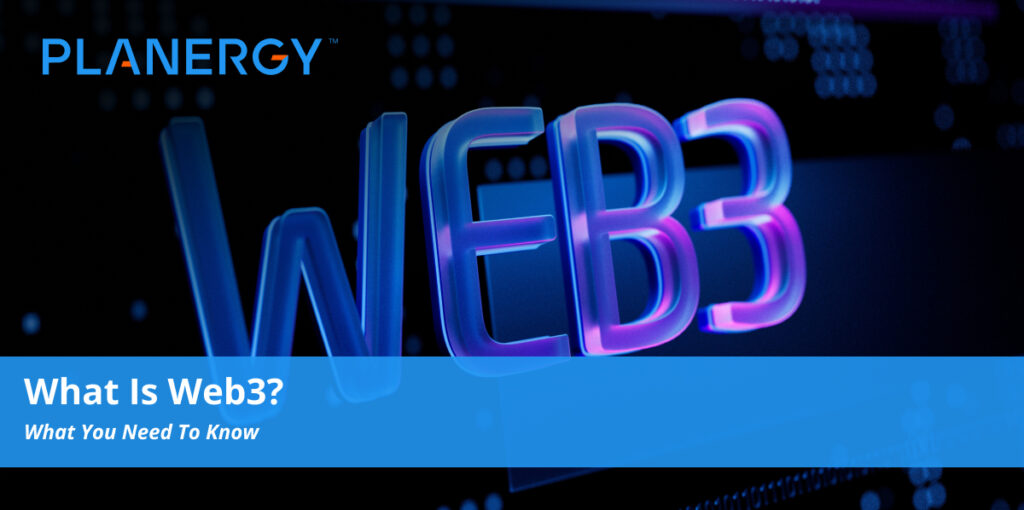Centralization has brought billions of people to the world wide web and created the infrastructure it lives on. The technology belongs to a small group of centralized entities that ultimately decide what should and should not be allowed on the world wide web.
Web3 aims to decentralize the WWW and break up the monopoly of large technology companies behind the internet as we know it today.
Web3 is about posting decentralized apps that run on blockchain technology.
Blockchain technology is what powers cryptocurrencies like Bitcoin, Ethereum, and Litecoin.
Web3 advocates say that it is about democracy, ownership, and freedom. Though Web3 is still in development and a few years away from being usable, it could be a massive departure from how we engage with the web and one another.
It may also be another overhyped platform for decentralized finance like cryptocurrency and trading non-fungible tokens (NFTs).
We don’t really know what web 3 will look like for a few years but we can take a look at the driving principles behind its development to put together an understanding of what it might look like. Before we Dive In, let’s take a look at how we got here.
The History of the Web as We Know It
Most of us think of the web as part of Modern Life. It was invented and has existed ever since. But, the web we use today is vastly different from its original intention.
Web 1.0: Read Only – 1990 – 2004
We owe the web as we know it to Tim Berners-Lee, a computer scientist who was working at CERN in Geneva, Switzerland. He is credited with inventing the WWW in 1989.
He developed the protocols that would become the World Wide Web by creating a series of open decentralized protocols that would allow people to share information from anywhere on the Earth.
The first version of his creation, now known as web 1.0, occurred between 1990 and 2004. It was mainly a series of static webpages and sites companies owned with little interaction between users.
People seldomly produce content which caused it to be known as the “read-only” web.
Web 2.0: Read-Write – 2004 – Present
Web 2.0 or the internet as we currently know it, started in 2004 with the dawn of social media channels. It morphed from a read-only platform into something we call read right.
Instead of companies providing content to web users, they also began to provide platforms that allowed users to share their own content and engage with one another.
As more people started to use the internet, A small collection of top companies began to control a disproportionate amount of traffic end value generated online. It’s because of Web 2.0 that we also have the advertising-driven revenue model that so many websites use today.
Users can create content, but often don’t own it or benefit from its monetization. Facebook and Instagram are prime examples of this model.
Web 3.0 – Read-Write-Own – TBD
The idea of web 3.0 shortened to Web3 was coined by Gavin Wood, co-founder of Ethereum cryptocurrency.
Gavin found the words for a solution for a problem that many early crypto adopters felt was an issue – simply put the web required too much trust.
Most of the web that we use today relies on trusting a handful of private companies to behave with the public’s best interests in mind.
Though the term was first coined in 2014, it hasn’t become mainstream until the last year or so, thanks to Packy McCormick, an investor with venture capital firm Not Boring Capital.
He worked to popularize the term by describing it as “the internet owned by the builders and users, orchestrated with tokens.
Proponents say it could take many forms, from decentralized social networks to play-to-earn video games that reward players with crypto tokens.
The enthusiasts say it will transform the internet as we know it, while critics believe it is nothing more than a rebranding effort for crypto.
What is Web3?
Web3, as we know it right now, is a catch-all term for the vision of a better internet.
It’s built on the foundation of blockchains, NFTs, and cryptocurrencies to place the power back in the hands of users for ownership.
Web3 aims to take the internet back from the hands of big tech giants like Elon Musk and Jack Dorsey, and put in the hands of the users.
Core Principles of Web3
It’s difficult to provide a strict definition of what web 3 is since the technology continues to evolve, but we know a few guiding principles are behind its creation.
Decentralized
Instead of having large portions of the internet owned and controlled by centralized big tech companies like Microsoft Amazon, and Metaverse acting as gatekeepers, ownership will be distributed amongst its users and builders.
Trustless
Web3 operates with incentives and economic mechanisms instead of relying on a group of trusted third parties.
Permissionless
Under Web3, everyone will have equal access to participation with no exclusions.
Native Payments
Web3 uses cryptocurrency to send money and spend it online instead of relying on Bank infrastructure and payment processors.
What Makes Web3 So Important?
The key features behind Web3 aren’t isolated and don’t fit into dedicated categories but we’ve tried to separate them to keep things simple and make them easier to understand.
Ownership
Web3 provides ownership of digital Assets in an unprecedented way. If for instance you’re playing a web 2 game and you purchase an in-game item, it’s tied directly to your account.
If the game two creators choose to delete your account you lose those items.
Or, if you decide to stop playing the game, you lose the value that you’ve invested in your in-game items.
With Web3, you’ll have direct ownership of your items through NFC. No one, not even the game creator has the ability to remove your ownership.
And if you stop playing, you have the option to trade-in or sell your game items on the open market to recoup your investment.
Identity
Under the current model, you create an account for each platform you use. Many users, for instance, have a Twitter account, a Reddit account, a YouTube account, and a Facebook account.
If you want to change your display name or profile picture, you have to do it across every account.
There is the option to use social sign-ins in some cases, but this presents a censorship issue.
With one click, these platforms can lock you out of your entire online life, and even worse, many of them require you to trust them with your personal data to create the account in the first place.
Web3 aims to solve these problems by giving you control of your digital identity with an Ethereum address and an EMS profile.
With your Ethereum address, You have a single login across platforms that is censorship resistant, anonymous, and most importantly, secure.
Resistance to Censorship
There is a massive power imbalance between platforms and the content creator who use them.
OnlyFans for example is a user-generated content adult site with more than 1 million content creators. Many of these creators rely on the platform as their primary source of income.
In August of 2021, OnlyFans announced plans to ban sexually explicit content which sparked rage throughout the community because users felt they were getting robbed of an income on a platform they helped to build. The backlash resulted in the decision being reversed.
Even though the creators won the battle, it brings attention to a problem for content creators. You lose your reputation and following that you’ve built if you choose to leave a platform.
With Web3, data is on the blockchain so when you decide to leave a platform, you can take everything with you and plug it into another interface that aligns better with your values.
Creating content on Web 2.0 requires creators to trust the platform to not change the rules. Censorship resistance is built into the web3 platforms to prevent this issue.
Decentralized Autonomous Organizations (DAOs)
Beyond owning your data, you can also own the platform as a collective using tokens that behave like shares in a company. Allow you to coordinate decentralized ownership of a platform and make decisions about how it behaves in the future.
DAOs are technically defined as agreed-upon smart contracts to automate all of the decentralized decision-making over a pool of tokens. Users with tokens vote on how resources are spent and the code automatically performs the voting outcome.
However, people define many of the Web3 communities as DAOs. The communities have varying levels of decentralization and automation with code. We expect these to continue to evolve in the future.
Native Payments
With the current structure of Web2, we rely on banks and payment processors, which alienates people without bank accounts or residents of certain countries.
Web3 removes this barrier with the use of tokens to send and receive money directly via browser without the need of a trusted third party.
Limitations of Web3
Even though web 3 offers a variety of benefits and its current iteration, there are still several limitations of the ecosystem that need to be handled for it to be successful.
Accessibility
Critical features like sign-in with Ethereum are already available for anyone to use for free. That said, the relative cost of transactions is still prohibited for many.
When 3 is not as likely to be used in developing nations because of the tie transaction fee. On Ethereum, the challenges are being addressed with network upgrades and layer 2 scaling solutions.
Though the technology is ready, we must have a higher level of adoption before we can make Web3 accessible to everyone.
Education
With the new paradigms that it introduces, web 3 requires learning different mental models than the one we are currently using. A similar drive for Education happened as web 1.0 was becoming popular in the late 90s.
Advocates of using the World Wide Web used a variety of educational techniques to educate the public such as metaphors like the information Highway and surfing the web to television broadcasts.
Though Web3 isn’t difficult, it is different and educational initiatives informing users about web3 paradigms are essential for it to be successful.
User Experience
At this time, the barrier to entry to using web3 is too high. Users have to understand the security concerns, comprehend complex technical documentation, and navigate user interfaces that are not particularly intuitive.
Wallet providers are among those at the forefront of working to address this issue, but a great deal of progress must be made before Web3 is widely adopted.
Centralized Infrastructure
Because the Web3 ecosystem is so young and continues to evolve quickly, it depends heavily on a centralized infrastructure with tools like Twitter, Discord, and GitHub.
There are a number of Web3 companies rushing to close these gaps, but building quality, reliable infrastructure takes time.
Without the technology to support it, we’ll never get to the next generation decentralized internet that Web3 promises.
Web3 has great potential, but, it is still a young ecosystem that will undergo significant Evolution before it becomes the new normal.
Though the term Web3 was coined in 2014, only a few of these ideas have recently become reality.
Over the course of the last year, we’ve seen a significant increase in the interest in cryptocurrency, experimentation with new forms of government, and revolutions and technology that make the future of the internet and Web3 look promising.




